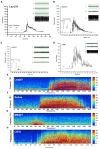D-Serine Contributes to Seizure Development via ERK Signaling
- PMID: 30971878
- PMCID: PMC6443828
- DOI: 10.3389/fnins.2019.00254
D-Serine Contributes to Seizure Development via ERK Signaling
Erratum in
-
Corrigendum: D-serine contributes to seizure development via ERK signaling.Front Neurosci. 2025 Feb 17;19:1541189. doi: 10.3389/fnins.2025.1541189. eCollection 2025. Front Neurosci. 2025. PMID: 40035060 Free PMC article.
Abstract
A seizure is one of the leading neurological disorders. NMDA receptor-mediated neuronal excitation has been thought to be essential for epileptogenesis. As an endogenous co-agonist of the NMDA receptor, D-serine has been suggested to play a role in epileptogenesis. However, the underlying mechanisms remain unclear. In the current study, we investigated the effects of antagonizing two key enzymes in D-serine metabolism on the development of seizures and the downstream signaling. Our results showed that serine racemase (SR), a key enzyme in regulating the L-to-D-serine conversion, was significantly up-regulated in hippocampal astrocytes in rats and patients who experienced seizure, in comparison with control rats and patients. L-aspartic acid β-hydroxamate (LaaβH), an inhibitor of SR, significantly prolonged the latencies of seizures, shortened the durations of seizures, and decreased the total EEG power in rats. In contrast, D-amino acid oxidase inhibitor 5-chlorobenzo[d]isoxazol-3-ol (CBIO), which can increase D-serine levels, showed the opposite effects. Furthermore, our data showed that LaaβH and CBIO significantly affected the phosphorylation of Extracellular Signal-regulated Kinase (ERK). Antagonizing or activating ERK could significantly block the effects of LaaβH/CBIO on the occurrence of seizures. In summary, our study revealed that D-serine is involved in the development of epileptic seizures, partially through ERK signaling, indicating that the metabolism of D-serine may be targeted for the treatment of epilepsy.
Keywords: D-serine; ERK; astrocyte; epilepsy; hippocampus; serine racemase.
Conflict of interest statement
The authors declare that the research was conducted in the absence of any commercial or financial relationships that could be construed as a potential conflict of interest.
Figures







Similar articles
-
Enhancement of Brain d-Serine Mediates Recovery of Cognitive Function after Traumatic Brain Injury.J Neurotrauma. 2018 Jul 15;35(14):1667-1680. doi: 10.1089/neu.2017.5561. Epub 2018 Apr 30. J Neurotrauma. 2018. PMID: 29648983
-
Astrocytes are involved in trigeminal dynamic mechanical allodynia: potential role of D-serine.J Dent Res. 2013 Sep;92(9):808-13. doi: 10.1177/0022034513498898. Epub 2013 Jul 23. J Dent Res. 2013. PMID: 23881719
-
Modulating NMDA Receptor Function with D-Amino Acid Oxidase Inhibitors: Understanding Functional Activity in PCP-Treated Mouse Model.Neurochem Res. 2016 Feb;41(1-2):398-408. doi: 10.1007/s11064-016-1838-8. Epub 2016 Feb 8. Neurochem Res. 2016. PMID: 26857796 Free PMC article.
-
Serine racemase and the serine shuttle between neurons and astrocytes.Biochim Biophys Acta. 2011 Nov;1814(11):1558-66. doi: 10.1016/j.bbapap.2011.01.001. Epub 2011 Jan 9. Biochim Biophys Acta. 2011. PMID: 21224019 Review.
-
Serine Racemase Expression Differentiates Aging from Alzheimer's Brain.Curr Alzheimer Res. 2022;19(7):494-502. doi: 10.2174/1567205019666220805105106. Curr Alzheimer Res. 2022. PMID: 35929621 Review.
Cited by
-
Epilepsy in inherited neurotransmitter disorders: Spotlights on pathophysiology and clinical management.Metab Brain Dis. 2021 Jan;36(1):29-43. doi: 10.1007/s11011-020-00635-x. Epub 2020 Oct 23. Metab Brain Dis. 2021. PMID: 33095372 Review.
-
Pathological Targets for Treating Temporal Lobe Epilepsy: Discoveries From Microscale to Macroscale.Front Neurol. 2022 Jan 7;12:779558. doi: 10.3389/fneur.2021.779558. eCollection 2021. Front Neurol. 2022. PMID: 35069411 Free PMC article. Review.
-
d-amino Acids in Health and Disease: A Focus on Cancer.Nutrients. 2019 Sep 12;11(9):2205. doi: 10.3390/nu11092205. Nutrients. 2019. PMID: 31547425 Free PMC article. Review.
-
Neurodevelopmental Disorders Associated with Gut Microbiome Dysbiosis in Children.Children (Basel). 2024 Jun 28;11(7):796. doi: 10.3390/children11070796. Children (Basel). 2024. PMID: 39062245 Free PMC article. Review.
-
Myo-Inositol Limits Kainic Acid-Induced Epileptogenesis in Rats.Int J Mol Sci. 2022 Jan 21;23(3):1198. doi: 10.3390/ijms23031198. Int J Mol Sci. 2022. PMID: 35163126 Free PMC article.
References
-
- Ballard T. M., Pauly-Evers M., Higgins G. A., Ouagazzal A. M., Mutel V., Borroni E., et al. (2002). Severe impairment of NMDA receptor function in mice carrying targeted point mutations in the glycine binding site results in drug-resistant nonhabituating hyperactivity. J. Neurosci. 22 6713–6723. 10.1523/JNEUROSCI.22-15-06713.2002 - DOI - PMC - PubMed
-
- Balu D. T., Li Y., Puhl M. D., Benneyworth M. A., Basu A. C., Takagi S., et al. (2013). Multiple risk pathways for schizophrenia converge in serine racemase knockout mice, a mouse model of NMDA receptor hypofunction. Proc. Natl. Acad. Sci. U.S.A. 110 E2400–E2409. 10.1073/pnas.1304308110 - DOI - PMC - PubMed
LinkOut - more resources
Full Text Sources
Research Materials
Miscellaneous

